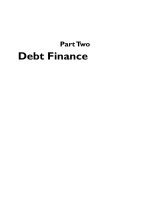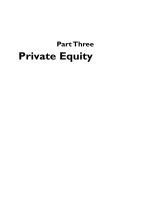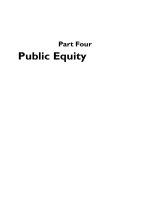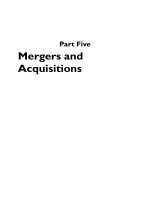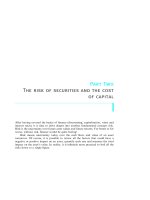Chapter 21 international corporate finance
Bạn đang xem bản rút gọn của tài liệu. Xem và tải ngay bản đầy đủ của tài liệu tại đây (199.11 KB, 33 trang )
Chapter 21
International
Corporate Finance
McGraw-Hill/Irwin
Copyright © 2010 by The McGraw-Hill Companies, Inc. All rights reserved.
Key Concepts and Skills
•
Understand how exchange rates are quoted and
what they mean
•
Know the difference between spot and forward
rates
•
Understand purchasing power parity and interest
rate parity and the implications for changes in
exchange rates
•
Understand the basics of international capital
budgeting
•
Understand the impact of political risk on
international business investing
21-2
Chapter Outline
•
Terminology
•
Foreign Exchange Markets and Exchange
Rates
•
Purchasing Power Parity
•
Interest Rate Parity, Unbiased Forward
Rates, and the International Fisher Effect
•
International Capital Budgeting
•
Exchange Rate Risk
•
Political Risk
21-3
Domestic Financial Management and
International Financial Management
•
Considerations in International Financial
Management
–
Need to consider the effect of exchange rates
when operating in more than one currency
–
Must consider the political risk associated
with actions of foreign governments
–
More financing opportunities when you
consider the international capital markets,
which may reduce the firm’s cost of capital
21-4
International Finance
Terminology
•
American Depositary Receipt (ADR)
•
Cross-rate
•
Eurobond
•
Eurocurrency (Eurodollars)
•
Foreign bonds
•
Gilts
•
London Interbank Offer Rate (LIBOR)
•
Swaps
21-5
Global Capital Markets
•
The number of exchanges in foreign countries
continues to increase, as does the liquidity on
those exchanges
•
Exchanges that allow for the flow of capital are
extremely important to developing countries
•
The United States has one of the most
developed capital markets in the world, but
foreign markets are becoming more competitive
and are often willing to try more innovative ways
to do business
21-6
Exchange Rates
•
The price of one country’s currency in terms of
another
•
Most currency is quoted in terms of dollars
•
Consider the following quote:
–
Euro 1.2695 .7877
–
The first number (1.2695) is how many U.S.
dollars it takes to buy 1 Euro
–
The second number (.7877) is how many Euros it
takes to buy $1
–
The two numbers are reciprocals of each other (1/
1.2695 = . 7877)
21-7
Example: Exchange Rates
•
Suppose you have $10,000. Based on the rates
in Figure 21.1, how many Japanese Yen can you
buy?
–
Exchange rate = 108.21 Yen per dollar
–
Buy 10,000(108.21) = 1,082,100 Yen
•
Suppose you are visiting Mumbai and you want
to buy a souvenir that costs 1,000 Indian
Rupees. How much does it cost in U.S. dollars?
–
Exchange rate = 42.882 rupees per dollar
–
Cost = 1,000 / 42.882 = $23.32
21-8
Work the Web Example
•
Thinking about going to Mexico for
spring break or Japan for your
summer vacation?
•
How many pesos or yen can you get
in exchange for $1,000?
•
Click on the web surfer to find out
21-9
Example: Triangle Arbitrage
•
We observe the following quotes
–
1 Euro per $1
–
2 Swiss Franc per $1
–
.4 Euro per 1 Swiss Franc
•
What is the cross rate?
–
(1 Euro / $1) / (2 SF / $1) = .5 Euro / SF
•
We have $100 to invest: buy low, sell high
–
Buy $100(1 Euro/$1) = 100 Euro; use Euro to buy SF
–
Buy 100 Euro / (.4 Euro / 1 SF) = 250 SF; use SF to buy
dollars
–
Buy 250 SF / (2 SF/$1) = $125
–
Make $25 risk-free
21-10
Types of Transactions
•
Spot trade – exchange currency immediately
–
Spot rate – the exchange rate for an immediate
trade
•
Forward trade – agree today to exchange currency
at some future date and some specified price (also
called a forward contract)
–
Forward rate – the exchange rate specified in the
forward contract
–
If the forward rate is higher than the spot rate, the
foreign currency is selling at a premium (when
quoted as $ equivalents)
–
If the forward rate is lower than the spot rate, the
foreign currency is selling at a discount
21-11
Absolute Purchasing
Power Parity
•
Price of an item should be the same in
real terms, regardless of the currency
used to purchase it
•
Requirements for absolute PPP to hold
–
Transaction costs are zero
–
No barriers to trade (no taxes, tariffs, etc.)
–
No difference in the commodity between
locations
•
For most goods, absolute PPP rarely
holds in practice
21-12
Relative Purchasing
Power Parity
•
Provides information about what causes
changes in exchange rates
•
The basic result is that exchange rates
depend on relative inflation between
countries
•
E(S
t
) = S
0
[1 + (h
FC
– h
US
)]
t
•
Because absolute PPP doesn’t hold for
many goods, we will focus on relative
PPP from here on out
21-13
Example: PPP
•
Suppose the Canadian spot exchange rate
is 1.18 Canadian dollars per U.S. dollar.
U.S. inflation is expected to be 3% per year,
and Canadian inflation is expected to be
2%.
–
Do you expect the U.S. dollar to appreciate or
depreciate relative to the Canadian dollar?
•
Since expected inflation is higher in the U.S., we would
expect the U.S. dollar to depreciate relative to the
Canadian dollar.
–
What is the expected exchange rate in one
year?
•
E(S
1
) = 1.18[1 + (.02 - .03)]
1
= 1.1682
21-14
Covered Interest Arbitrage
•
Examines the relationship between spot
rates, forward rates, and nominal rates
between countries
•
Again, the formulas will assume that the
exchange rates are quoted in terms of
foreign currency per U.S. dollar
•
The U.S. risk-free rate is assumed to be
the T-bill rate
21-15
Example: Covered Interest
Arbitrage
•
Consider the following information
–
S
0
= .8 Euro / $ R
US
= 4%
–
F
1
= .7 Euro / $ R
E
= 2%
•
What is the arbitrage opportunity?
–
Borrow $100 at 4%
–
Buy $100(.8 Euro/$) = 80 Euro and invest at 2% for 1
year
–
In 1 year, receive 80(1.02) = 81.6 Euro and convert back
to dollars
–
81.6 Euro / (.7 Euro / $) = $116.57 and repay loan
–
Profit = 116.57 – 100(1.04) = $12.57 risk free
21-16
Interest Rate Parity
•
Based on the previous example, there
must be a forward rate that would prevent
the arbitrage opportunity.
•
Interest rate parity defines what that
forward rate should be
)(1 :Approx.
)1(
)1(
:Exact
0
1
0
1
USFC
US
FC
RR
S
F
R
R
S
F
−+=
+
+
=
21-17
Unbiased Forward Rates
•
The current forward rate is an unbiased estimate of
the future spot exchange rate
•
This means that, on average, the forward rate will
equal the future spot rate
–
If the forward rate is consistently too high
•
Those who want to exchange yen for dollars would only be
willing to transact in the future spot market
•
The forward price would have to come down for trades to
occur
–
If the forward rate is consistently too low
•
Those who want to exchange dollars for yen would only be
willing to transact in the future spot market
•
The forward price would have to come up for trades to occur
21-18
Uncovered Interest Parity
•
What we know so far:
–
PPP: E(S
1
) = S
0
[1 + (h
FC
– h
US
)]
–
IRP: F
1
= S
0
[1 + (R
FC
– R
US
)]
–
UFR: F
1
= E(S
1
)
•
Combining the formulas we get:
–
E(S
1
) = S
0
[1 + (R
FC
– R
US
)] for one
period
–
E(S
t
) = S
0
[1 + (R
FC
– R
US
)]
t
21-19
International Fisher Effect
•
Combining PPP and UIP we can get the
International Fisher Effect
•
R
US
– h
US
= R
FC
– h
FC
•
The International Fisher Effect tells us
that the real rate of return must be
constant across countries
•
If it is not, investors will move their money
to the country with the higher real rate of
return
21-20
Overseas Production:
Alternative Approaches
•
Home Currency Approach
–
Estimate cash flows in foreign currency
–
Estimate future exchange rates using UIP
–
Convert future cash flows to dollars
–
Discount using domestic required return
•
Foreign Currency Approach
–
Estimate cash flows in foreign currency
–
Use the IFE to convert domestic required return to
foreign required return
–
Discount using foreign required return
–
Convert NPV to dollars using current spot rate
21-21
Home Currency Approach
•
Your company is looking at a new project
in Mexico. The project will cost 9 million
pesos. The cash flows are expected to be
2.25 million pesos per year for 5 years.
The current spot exchange rate is 10.91
pesos per dollar. The risk-free rate in the
US is 4%, and the risk-free rate in Mexico
8%. The dollar required return is 15%.
–
Should the company make the investment?
21-22
Foreign Currency Approach
•
Use the same information as the previous
example to estimate the NPV using the
Foreign Currency Approach
–
Relative inflation difference from the
International Fisher Effect is 8% - 4% = 4%
–
Required Return = (1.15*1.04 – 1) = 19.6%
–
PV of future cash flows = 6,788,537 pesos
–
NPV = 6,788,537 – 9,000,000 = -2,211,463
pesos
–
NPV = -2,211,463 / 10.91 = -202,701
21-23
Repatriated Cash Flows
•
Often, some of the cash generated from a
foreign project must remain in the foreign
country due to restrictions on repatriation
•
Repatriation can occur in several ways
–
Dividends to parent company
–
Management fees for central services
–
Royalties on the use of trade names and
patents
21-24
Short-Run Exposure
•
Risk from day-to-day fluctuations in
exchange rates and the fact that
companies have contracts to buy and sell
goods in the short-run at fixed prices
•
Managing risk
–
Enter into a forward agreement to guarantee
the exchange rate
–
Use foreign currency options to lock in
exchange rates if they move against you, but
benefit from rates if they move in your favor
21-25

